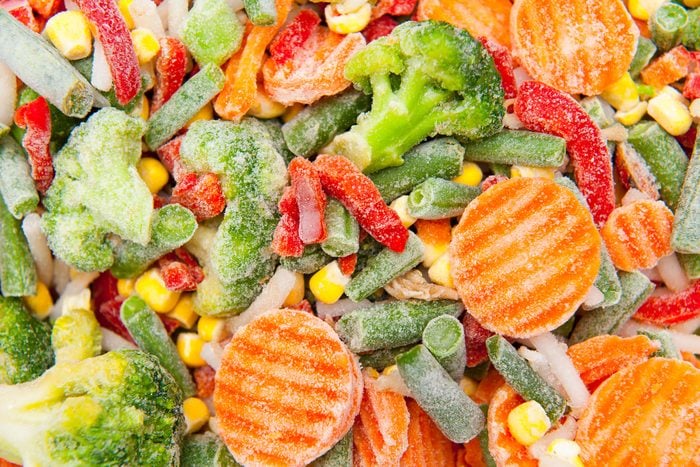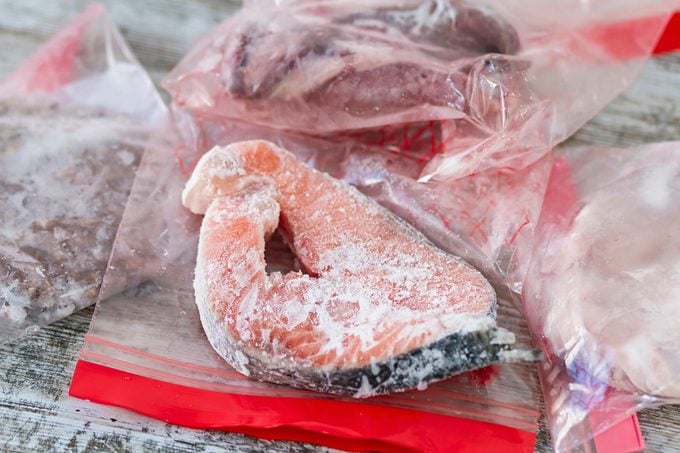Is Freezer-Burned Food Safe to Eat?
Updated: Apr. 23, 2024

When you take chicken out of the freezer and it's covered in ice crystals, you might wonder, is freezer burn safe to eat? Here's a closer look at how freezer burn affects your food.
For those of us who lead busy lives, meal prepping is the best way to ensure we’re eating at home without having to spend time cooking. If your meal prep involves freezing food, then you’ve probably come across the dreaded freezer burn. When you pull out make-ahead freezer meals or even a pint of ice cream and find a layer of ice crystals, is freezer burn safe to eat?
Here’s a closer look at what that icy crust is.
What is freezer burn?
Freezer burn occurs when your food dries out. Those ice crystals you see on your frozen leftovers are created by moisture that escaped from the food. This happens for one of two reasons: either you didn’t store your food properly or your food has been in the freezer for a long time. Everything will start to turn to ice if left in there too long.
Foods with a higher water content are more likely to get freezer burn. Bananas, citrus fruits and other items on our list of foods that freeze well won’t get freezer burn as quickly as something like ground meat.
What does freezer burn look like?
On most foods, it looks like a layer of ice. For example, if you open up a bag of frozen strawberries for a smoothie, you might find icy berries toward the top of the bag. When you dig into a tub of ice cream, ice crystals may be climbing up the sides of the container and onto the ice cream itself.
On certain types of food, freezer burn can change how the food itself looks, instead of adding a layer of ice.
Is freezer-burned food safe to eat?
Yes. Though it may be lacking in the taste department, food with freezer burn is still safe to consume. You may not enjoy the flavor or dried-out texture of freezer-burned frozen pizza, but it has no impact on the quality of your food or your health. Freezer-burned food does not lose any of its nutrients either. However, keep in mind that food doesn’t last forever in the freezer.
When cooking with freezer-burned food, here’s how to salvage as much flavor and texture as possible: Use fresh herbs to replace the natural flavor lost to freezer burn. Use the slow cooker to fix tough meat. And add beef or chicken broth to freezer-burned meat or poultry to help replace some of the lost moisture.
Editor’s Tip: You want to extend the shelf life of ground beef but still maintain its taste and quality. So, how long can you freeze ground beef?
Is it safe to refreeze food?
Yes, according to the U.S. Department of Agriculture, it’s safe to refreeze food after thawing in the refrigerator. This is true for both cooked and raw food. Make sure to freeze your leftovers within three to four days. The exception: If your food has been sitting out at room temperature for more than two hours, throw it away.
While it’s safe to refreeze food, the process may dry out the food and lower the quality.
How Freezer Burn Affects Different Foods

It’s possible for any food to develop freezer burn, but the effect differs among types of food. Because freezer burn pulls moisture out of food, foods with a high water content are more affected than others.
Red meat and pork
Red meat and pork can take on a brown or gray color when freezer burn sets in. These discolored areas are safe to eat but are usually dry and tough when cooked. Here’s how long to freeze ground beef.
Chicken and poultry
Can you freeze chicken? Yes! When poultry (such as chicken breasts) become freezer-burned, the edges appear beige or gray. Once cooked, these parts of the chicken have a leathery texture and are dry and tough.
Fruits and veggies
In addition to being covered in ice crystals, freezer-burned fruits and vegetables tend to look shriveled and sad. As they lose their moisture, they shrink considerably. It’s helpful to keep in mind how long frozen vegetables last (three months) when meal planning. Consider using up leftover vegetables in a soup or stew and then freezing the soup to seal in the moisture.
Ice cream
Ice cream may be the least forgiving food when it comes to freezer burn. Freezer-burned ice cream loses moisture and creaminess as it sits in the back of the freezer. Even once you scrape off the ice crystals, it won’t taste the same as fresh ice cream. Don’t let good ice cream go to waste! Whip up one of our ice cream desserts before the ice crystals take over.
How to Prevent Freezer Burn
The number one rule for preventing freezer burn is to store all your food properly. That means sealing it in airtight containers (look for plastic and glass that are specifically freezer-safe) or wrapping it tightly with plastic wrap. Invest in products to help freeze food such as a vacuum sealer, reusable freezer bags and portion pods.
You should also make sure your freezer isn’t too cold or too packed full of groceries and containers. Leave space for air to circulate, and keep the temperature around 0°F. If you plan on freezing leftovers, make sure everything is completely cool before it goes in the freezer. Sealing it up when it’s still warm will cause steam and condensation to form on your food, which is just freezer burn waiting to happen.
Armed with these tips (and a few high-quality storage containers), you can expect a future free of freezer burn. Hello, delicious defrosted dinner!
